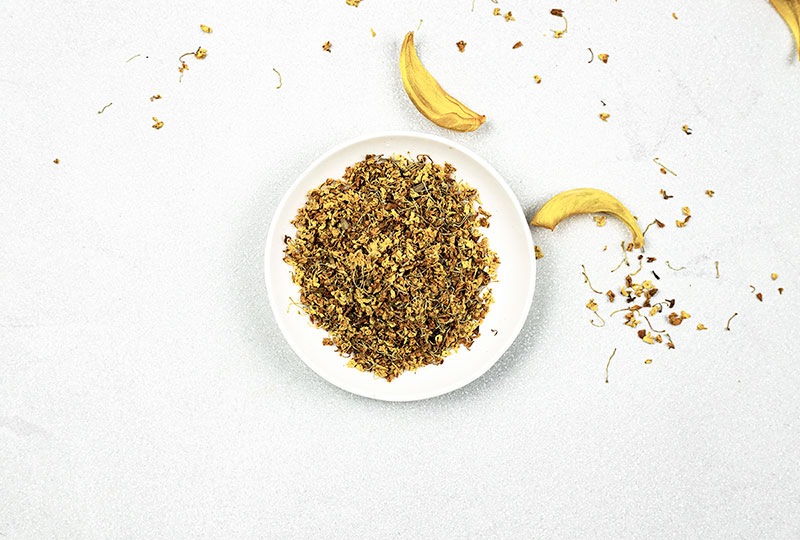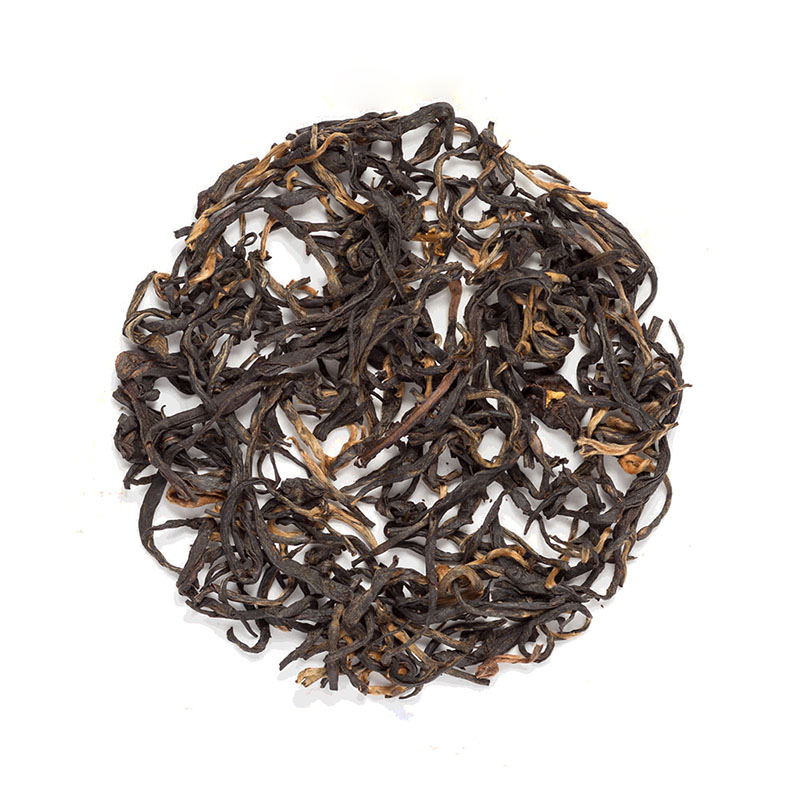Osmanthus Tea Drinking Guide
Osmanthus flower is one of the most exquisite flowers used for making pure tea or scenting real teas. It’s incredibly beautiful and has a unique sweet, creamy, peachy and floral aroma and flavor. In fact, this flower tea is unlike any other flower tea in the world and can truly surprise you with the intensity of flavor. If you haven’t tried it before, summer may be the best season to start experimenting. Learn what is osmanthus herbal tea, what are the benefits, how to use osmanthus dried flowers in different ways and how to brew a perfect cup with this delicious yellow blossoms.


What is osmanthus tea
Osmanthus or osmanthus fragrans is a small tree mostly grown in China and Japan. It belongs to the same botanical family as olives. The other name of this tree is sweet olive or sweet osmanthus. Indeed, the flavor of these small little blossoms is incredibly sweet. Osmanthus blossoms are harvested in late summer, dried and used for making Chinese flower tea, scenting real teas or making jams, liqueurs, cakes and other food. Osmanthus is a very popular ingredient in cosmetics too. Flowers are small and beautiful with an intense yellow golden color. They give a pale yellow liquor with a very rich aroma. The flavor of this tea cannot be easily described. It contains a range of notes, from honey to creamy, peachy, a bit spicy and very captivating.Does osmanthus tea have caffeine?
Almost all herbal teas are caffeine free, so pure dried osmanthus flowers are caffeine free too. Scented osmanthus tea blended with real white, green, black, oolong or pu'erh teas will contain caffeine. How much caffeine will they have will depend on the type of tea and many other factors.Osmanthus tea benefits
It’s not only the scent and flavor that make osmanthus a worthy ingredient in any kitchen cabinet. Studies showed that osmanthus flowers are rich in polyphenols[1] and niacinamide and may have many potential health benefits. The type of polyphenols in osmanthus tea will be different that the type of polyphenols in green tea, but some of the benefits may be quite similar:- Boosting immune system
- Reducing inflammation
- Helping with digestive problems
- Neuroprotective activity and supressing the appetite
- Sedative effect
How to use osmanthus tea
Dried osmanthus flowers are extremely versatile. You can use them for brewing hot or cold tea, iced tea, add them to your creams, puddings or jellies, make a unique milkshake or blend with other pure teas to get a truly unique flavor. They blend well with almost any type of tea. Try it with white, green, black, pu’er and oolong tea, and even tisanes like mint. Osmanthus flowers are likely to cause no side-effects,[9] so try using them in different ways to find the best flavor balance.
Dry Osmanthus Flowers
How to Brew Osmanthus Tea
To make pure osmanthus tea, use only fresh, dried high quality blossoms. To preserve the freshness, store them properly and keep in airtight containers away from any source of humidity, heat and sunlight. Use fresh spring water when making osmanthus tea. One leveled or rounded teaspoon of dried blossoms will be enough to make one cup of tea. Bring water to a boil and steep for about 3 minutes. If possible, use glass teaware to enjoy the beauty of these delicate flowers. Alternatively, you can make osmanthus tea by using the boiling technique. Studies showed that boiling only 2 grams of blossoms per litre of water for 20 minutes could give a high potency drink that may help boost immunity[10]. If bitter, add a bit of honey. If you want to enhance the naturally sweet and creamy flavors, honey is the best sweetener for this tea.Best osmanthus tea to buy
Unfortunetely, osmanthus is still not widely popular outside of Asia. In the United States it's mostly available in different tea blends. A delicious example is Ebony Osmanthus, a unique blend with Indian black tea and dry osmanthus. If you are buying pure osmanthus, check if it’s fresh and clean. Wash the flowers with a very short infusion to remove any potential dust or other particles.
Ebony Osmanthus black tea blend
Disclaimer: This article is for informational purposes only. It’s not intended to replace medical advice, diagnosis or treatment. Every person is different and may react to different herbs and teas differently. Never use teas or herbs to treat serious medical conditions on your own. Always seek professional medical advice before choosing home remedies.
References:
[1] https://www.sciencedirect.com/science/article/pii/S0254629915002276 [2] https://www.researchgate.net/publication/286648528_Effect_of_an_osmanthus_fragrans_flower_beverage_on_the_antioxidant_activity_in_healthy_individuals [3] https://www.hindawi.com/journals/ecam/2013/304290/ [4] https://www.hindawi.com/journals/ecam/2013/304290/ [5] https://www.ncbi.nlm.nih.gov/pmc/articles/PMC3872418/ [6] https://bmcsystbiol.biomedcentral.com/articles/10.1186/s12918-017-0523-0 [7] https://pubmed.ncbi.nlm.nih.gov/23519146/ [8] https://pubmed.ncbi.nlm.nih.gov/28917370/ [9] https://www.researchgate.net/publication/280834909_The_safety_of_Osmanthus_fragrans_ethanol_extract_treatment_in_BALBc_mice [10] https://www.researchgate.net/publication/286648528_Effect_of_an_osmanthus_fragrans_flower_beverage_on_the_antioxidant_activity_in_healthy_individuals [1] https://www.researchgate.net/publication/280119171_Osmanthus_fragrans_Flower_Extract_and_Acteoside_Protect_Against_d_-Galactose-Induced_Aging_in_an_ICR_Mouse_Model [2] Robert W. LUCAS; The Creative Training Idea Book: Inspired Tips and Techniques for Engaging and Effective Learning
More from:
SLL




Leave a comment